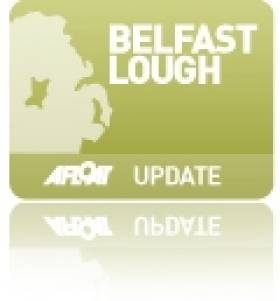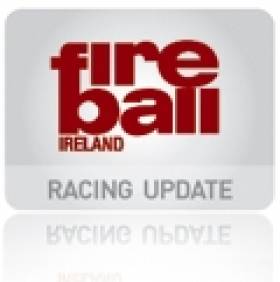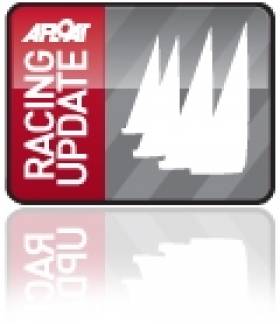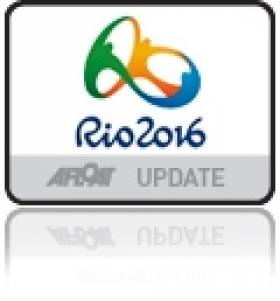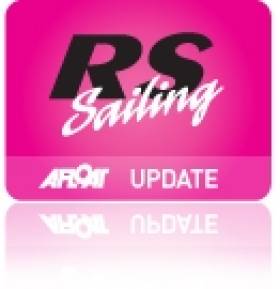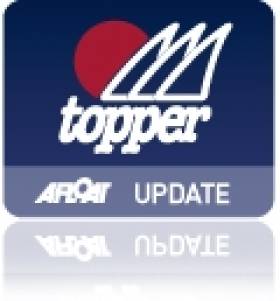Displaying items by tag: Ballyholme Yacht Club
Australian Glenn Ashby was wing trimmer on the Emirates Team New Zealand AC72 in last year's America's Cup. He is a multihull specialist, with 14 World Championships across three classes to his name.
Ballyholme Yacht Club, host of the 2014 F18 World Championships, is delighted that the 37 year old sailmaker from Bendigo Yacht Club in Victoria will be helming with child-hood friend Brett Goodall as crew. He has won the F18 Worlds three times already. The F18 is a fast catamaran with a spinnaker and double trapeze crewed by two people and is a fully International Sailing Federation (ISAF) recognised class.
Goodall has been on the entry list for some time, but until now his helmsman was unknown. Brett: "I'm happy Glenn will sail with me in Ireland. Glenn has been out of F18 sailing for some time and has focussed succesfully on the A-Cat. But this feels like a sort of homecoming to get back on a F18 again". Olivier Bovyn, International F18 Class President said " I am confident Ballyholme will provide our Class with a top quality event, merging proper and fair sailing with friendly sailor parties, and I am certain success will reward all your efforts and involvement in building up such an important organisation. Further to this, I would like to sincerely thank all funding partners, from proud sponsors to local governing bodies, whose support makes this 15th F18 World Championship possible. Wishing you all the best".
Ballyholme Yacht Club is highly experienced in running events of this magnitude and has among its members three World Champions and 11 Olympic sailors. BYC Is delighted to have club member Bill O'Hara as Principal Race Officer. Bill is an Independent Sports Professional and an Olympian, and Principal Race Officer for the Volvo Ocean Race. The Jury Chairman will be Ewan McEwan (GBR) who is Chief Umpire of the Extreme 40 series.
The club is located on the eastern side of Bangor on Ballyholme Bay in Belfast Lough where racing will take place. The Lough is one of the best sailing waters in the UK with few hazards and little tide.
#rs – Some statistics from the Irish RS Sprint Championships 2014 at Ballyholme YC last weekend. 46 individual competitors (including Neill Strain's swaps), 40 Flight Starts, 214 recorded finishes, 490 individual hoists and drops (taking out DNFs etc), and a lot of weary bodies, not just the competitors! Full Sprint results are available to download below as a pdf file.
The Irish RS400 fleet has a full calendar for the year, along with the RS200s and Fevas, but with the exam season in full progress, there is usually a gap in May. The Sprints have thus been moved to fill this gap, and the excellent turn out justified the ongoing inclusion of this event in the calendar.
23 RS400s and an RS200 rolled out for the Annual Irish RS Sprint Championships, held for the first time in the North, with hosts Ballyholme Yacht Club under the guidance of our favourite Race Officer Robin Gray, putting on a tremendous event, in what always seems to me to be a complete nightmare of an event to run. Robin clearly loves a challenge, as he has offered to do it again next year!
Always a great opportunity to get some boat handling practice in, it also provides a workout for those of us navigationally challenged, and more than a few salvages were provided on my boat by Steve advising me where to point the boat next. The whacky M course was a great success, sort of slaloming to the left, and then having an on the edge kite reach across the bottom, to make sure you didn't recover too much before the next race.
We have always asked that we are not kept sitting around too long, and Robin's team kept things pinging off at a furious rate, not giving you time to realise how your body was slowly disintegrating as the afternoon progressed. That said, I was pleased to see that some of the young ones were whinging as much as we elder statesmen, about how battered they felt.
In a Northerly there are few better venues than Ballyholme, with champagne conditions (can we finally park that expression, though it does serve the purpose I guess) of 15 knots steady, a 3-4 foot short swell allowing some fruity downhill slides. As good as it gets I'd say. Also clearly suits the locals, with Bob Espey and Gareth Flanagan and their respective engineers, Mike Gunning and Dave Fletcher, leading the way, along with Sean Cleary and Steve Tyner from Greystones, current Inlands Champs, in amongst the leaders. The flights were rejigged midway through Saturday, and again for Sunday, giving no-one any idea who was winning, apart from the obvious fact the Bob and Mike were running away with it. That said, everyone had a piece of the action, and as always, when the racing is good, we all go home happy.
Biggest thanks however have to go to the mark layers, who did an unbelievable job to lay and move so many marks with so little delay, outstanding.
Next up is the slightly less chaotic RS Northerns at Strangford Lough Yacht Club in late June, with usual format windyleewards; though if the size and intensity of the Easterns was anything to go by, carnage and chaos will return. We should have some serious entertainment, as the deep southerners, from the fast growing and worryingly talent packed Cork fleet, fresh from their own Sprint event, rejoin the fray. Great times for the RS fleet.
#fireball – Barry McCartin and Conor Kinsella (RStGYC) became the new Ulster Fireball champions in a thrilling final day of racing at Ballyholme YC. The first regional Fireball event of the season saw fourteen entries and some really great sailing conditions at an extremely friendly club noted for it's support of dinghy and small boat racing. The winning team scored three first places on day two of the event to catapult into victory overall. On Saturday night after the first three races of the six race series Noel Butler and Stephen Oram (DMYC) had a narrow lead over Kenny Rumball and Scott Flanagan. McCartin/Kinsella languished down the score card after suffering a snapped kicker and a broken main halyard. Overnight assistance from Kenny Rumball saw their boat back into tip-top shape.
Day one saw fantastic if challenging conditions with strong winds and even stronger gusts combined with a disturbed sea state making smooth upwind progress tricky. To add to the test there were big shifts and even the odd flat patch in the offshore breeze. The compensation came in the offwind legs. Race officer Robin Gray set superb sharp reaching angles resulting in some very fast and some very exciting sailing. On day one Butler/Oram and Rumball/Flanagan showed exceptional boat-speed pulling away from the rest of the fleet for what often looked like a private duel of speed and tactics.A bit further back Conor Clancy and Jim Devlin scored two thirds and a sixth, McCartin/Kinsella posted a 4, 3, DNF while Niall McGrotty and Neil Cramer were a very steady 5,4,5. Further back there was close racing throughout the fleet. Frank Miller/Grattan Donnelly battled with Jon Evans/Aidan Caulfield and Michael Ennis/Marie Barry on almost even points troughout the event. Positions mid-fleet shifted like snakes and ladders, often due to unforced errors and the occasional swim.
The intention to go for four races on day one was stymied by a significant wind shift during race two and a bit of a delay resetting the course in a breeze which took time to settle into a steady direction. That delay combined with some signs of tiredness and some swimming meant the fleet headed for shore after race three. That tiredness led to a bit less support at the bar than is normal at Fireball events but a super meal at the club had the fleet eating together and risking the odd pint. A few heroes were seen in a local nightclub much later but many had an early night resting body and soul.
Sunday looked breezy from ashore but by the time the course was set conditions though still lively were distinctly steadier and the water a lot flatter. At this point any reasonable gambler would have put their money on Butler/Oram or Rumball/Flanagan.
Race officer Robin Gray was true to his word and started race one on time catching out a couple of boats who launched late and almost catching out McCartin/Kinsella who made the start with just seconds to spare. The pair stayed level with leaders up the course and on the reaches and broke away with a useful gust as they rounded into the run, consolidated by gybing onto starboard and into more pressure two thirds the way down. They held this lead to take the bullet.
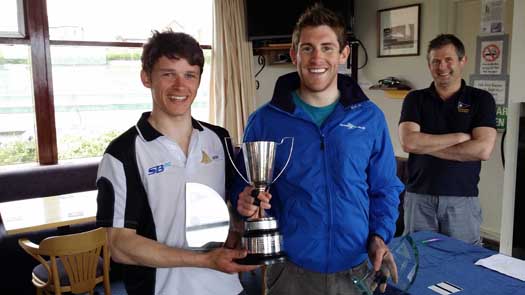
Ulster Fireball champions – Barry McCartin (left) and Conor Kinsella (RStGYC). Photo: Frank Miller
In race five McCartin/Kinsella went right on the first beat to lead at the windward mark. They held on with Rumball/Flanagan snapping at their heels and broke away with a gybe set into more pressure which gave them the distance to hold Rumball/Flanagan off for the win. In the final race the pair had a bad start and arrived at the windward mark in about 6th but used the gusts on the reaches to close into third behind Butler/Oram and Rumball/Flanagan. They stayed close on the beat to the two boats ahead and played the shifts, managing to get left of the leaders and ahead on shifts and then concentrated on holding off Butler/Oram. That pair suffered a snapped spinnaker sheet on one reach but managed a fast repair and sailed on with a shorter sheet.
McCartin/Kinsella's victory in the final race put them on an even score of ten points with Butler/Oram and Rumball/Flanagan but the three wins gave them the edge for overall victory in what was a thrilling event. The silver fleet prize was won by Mary Chambers and Brenda Maguire who displayed solid sailing in often tricky conditions. The event marked a great start to the Fireball summer season, with a bigger turnout anticipated at the Fireball Open event in Clontarf on June 14th/15th.
Results available below to download
Ballyholme Yacht Club Boasts of 110–Day Racing Season
#ballyholmeyc – Can any other Irish club boast over 110 days of racing this year? Ballyholme Yacht Club on Belfast Lough has been awarded the 2014 RYA NI Youth National championships to add to its already full calendar with the F18 World Championships, Irish Laser Championships, IMA Northerns, Fireball Northerns, RS Sprint Series. All this and the club still has yet to announce keelboat events for the new NI Restricted Keelboat Racing Association.
The go–ahead dinghy club has a coaching series starting this morning for Lasers 4.7, Radials, Standards, Toppers and Double–handed boats sponsored by North Down Borough Council.
More details here
120 Crews For F18 World Championships at Ballyholme Yacht Club
#F18 – Ballyholme Yacht Club is the host for this summer's prestigious F18 catamaran World Championships as Afloat first reported last July. The event will be sailed on Belfast Lough and is one of the largest in Ireland this year and runs from 4th till 11th July.
The Worlds will attract 120 multihulls and crew and this contingent, together with their managers, trainers, friends and family will bring over 500 visitors to North Down. Local competitors include Adrian Allen and Richard Swanston.
The F18 is a fast catamaran with a spinnaker and double trapeze crewed by two people and is a fully International Sailing Federation (ISAF) recognised class with large fleets all over the world. The class is made up of over 50% professional and semi-professional sailors including World Champions, Olympians and major event winners.
Ballyholme Yacht Club is highly experienced in running events of this magnitude and is delighted to have club member Bill O'Hara as Principal Race Officer. Bill is an Independent Sports Professional and an Olympian, who is currently Rules Coach for the Irish Sailing Association and Principal Race Officer for the Volvo Ocean Race. The club has among its members three World Champions and 11 Olympic sailors.
Ballyholme's Ice Breaker Attracts 49 Boat Laser Fleet
#ballyholme – Northern Ireland's largest open dinghy series began on Belfast Lough today with 49 Lasers competing in Ballyhome's Icebreaker series. Gareth Flannigan was the winner of today's first race with Hammy Baker second and Chris Boyd third in the standard class. Tim Brow was the radial winner and James Moore won the 4.7 fleet.
The series runs though to Sunday 30th March with 22 races. This year an F18 Multihull fleet are gearing up for the F18 worlds at Ballyholme YC in June 2014. Adrian Allen won the first race. The results are here.
Dublin 49ers Expected for Ballyholme Nationals
#49er – For the first time in many years, Ballyholme Yacht Club (BYC) orgsnisers on Belfast lough are hoping for double figures for the Mackey Opticians sponsored Irish 49er nationals, especially if a few of the Dublin fleet travel for the October 5th event.
It will be a very busy weekend at Ballyholme bay with Race 4 of the Autumn Series on Sunday morning and Race 1 of the BYC Icebreaker series on Sunday morning.
London 2012 Olympians Ryan Seaton and Matt McGovern (currently competing at the 49er worlds in Marseille, France) have been working hard to organise boats for all the competitors.
There will be practice racing on Friday 4th for those who haven't stepped on a 49er in a number of years or ever before.
The briefing will be at 10:30 on Saturday morning with races starting as soon as possible afterwards. We hope for 6 quick races on Saturday with 3-4 on Sunday starting earlier. Sailing instructions will be available at the briefing and will be dependent on the weather conditions.
There is a perpetual trophy available for the winning 49er and Mackey Opticians are donating two pairs of polarized sunglasses (value up to £150 each) for the winning pair.
Two races were sailed today in predominantly light conditions at the combined RS Championships at Ballyholme Yacht Club. The race officer made a good call to postpone proceedings until Sunday when the afternoon breeze completely shut down.
There are 18 RS 400's, 8 RS200's and 6 RS Fevas competing.
RS400 Results:
1st E.Ryan J.Ryan R1(2) R2(1)
2nd J.Espey M.Gunning R1(1) R2(3)
3rd D.Cheyne S.Kane R1(3) R2(5)
4th M.Ferguson J.Tomalin R1(7)R2(2)
5th R.Seaton M.McGovern R1(5)R2(4)
6th G.Flannigan D.Fletcher R1(4)R2(7)
RS200 Results:
1st C.Coffey H.Cassidy R1(2) R2(1)
2nd F & K O'Rourke R1(1) R2(5)
3rd R.Milligan P.Blamphin R1(5) R2(2)
RS Feva Results:
1st N.Eames M.Fekkes R1(3) R2(1)
2nd B.Coburn A.Mitchell R1(1) R2(5)
3rd R.Fekkes A.Harley R1(1) R2(6)
RS Dinghy Action Moves To Ballyholme Yacht Club, Belfast Lough
#RS – After a few weeks rest following the bumper turnout RS Nationals in July, the action moves to the new RS400 fleet's home at Ballyholme in Bangor.
Ballyholme has seen a great influx of RS400s to go with the RS200s already there, and has attracted some of Ulsters top racing talent, evidenced by July's two top Irish performances from Bob Espey/Mike Gunning, and Michael Ferguson/ Jeremy Tomalin at the Nationals. Whilst they will undoubtedly form the strongest teams to beat this weekend, there will be plenty of other talent tackling them, with Irish 49er Olympians Ryan Seaton and Matt McGovern flying back for the weekend from Marseilles, multiple Irish Laser and SB20 Irish Champion Gareth Flannigan, and recent top youth helm at the British Nationals, Chris Eames.
All the old timers will be there, licking their wounds from the recent shoeing handed out by the new boys in the fleet. Liam Donnelly will be fresh from the UK Nationals, and always as competitive as ever, at 60 something years of age, spearheading the RNIYC charge, along with Whitehead's John Lewis, another Scorpion veteran, who will be keen to see how he goes in his first RS400 event. From RNIYC, former Squib Irish champion Gordy Patterson has been spotted practising, and seems to be getting to grips with the faster boat (though he has years of SB3ing to call on), and someday Ruan O'Tiarnaigh will get his boat out too; whilst the Southern efforts will be led by Emmet Ryan and Simon Herriott, along with up and coming Sean Cleary and Any Verso from Greystones.
Rumour has it 4-5 good teams from the Cork area are on the brink of getting 400s, which could lead to further strengthening of the fleet in Ireland, along with some good new Dublin sailors, and 5 new boats have arrived into other Northern clubs in the past fortnight, so turnouts should be increasingly strong going into 2014.
McCready Sailboats have recently been appointed as RS Boat Dealers for Ireland, following a few years of direct sales only, and are especially keen to push the RS Feva, supplying three boats for crews to test, and hopefully we will start to see a resurgence in this great youth boat next year, with their support.
The RS200s at Ballyholme will face some stiff competition from the ever strong Greystones contingent, who usually take the prizes home, and it would be great to see this class strengthening in the north as the RS Family gain a stronger foothold.
Racing in the Bay runs Saturday and Sunday, with beer and grub on Saturday and some decent northerly breeze looking set to roll in some surfing waves and maximise the craic.
Northern Ireland Sailor Leads Topper Worlds in France
#topper – Liam Glynn from Ballyholme YC is leading the Topper World Championships in Loctudy, Brittany, France. In a fleet of 102 boats, he has already registered 3 firsts, 1 second and a third.
He has already won the Irish Nationals this summer at Donaghadee where conditions were similar with little breeze and lots of tide. Hopefully there is a little bit more wind forecast today although tomorrow is looking light without a sea or land breeze kicking in during the afternoon. Today is the first of the races where the gold and silver fleets have been separated and the racing starts properly. Ben Martin (BYC), Tom Purdon (BYC and SLYC), Peter Gilmore (SLYC), Lucy Mearns (SLYC) and Emily Hill (CAYC) should also make the Gold fleet.
Today wind-speed up to 12 knots , sunshine but also tidal stream were expecting the 117 contestants for the International Topper Class World Championship.
Racers were disturbed at the starting line by the tidal current as pointed out the young British William Birch Tomlinson who got the 4 th place for this evening.
"In the first and second race it was hard to stay under the starting line as the current made the dinghies drift.Then in the following legs everything was about taking the right decision and tack at the right moment to get the windward mark."
The Irish Liam Glynn, at the head of the overall results seems to share this point of view:
"The wind was quite steady but it was tricky to deal with waves and current at the starting line. Moreover beating to get the windward mark was one-sided and tide wasn't helping."
A light land breeze strengthened the wind-speed on the race and the real wind eventually dropped at midday. Then the land breeze had to vanish because of some clouds covering the body of water.
As for the French contestants, the process of learning how to sail this typically Anglo-saxon dinghy is still on the way.
"I never sailed a Topper before and I am far from the top ten but I don't really mind, Chloé Le Bars confesses. I usually sail Lasers and I'm not used to the Toppers' tricky balance. However I'm starting to get hold of this new boat even though what you feel when you hold the tiller is so different."
When we consider Marie-Anne Resmond the transition is even stiffer since she evolved from oppies to sporty catamarans. Hence a tough but pleasant return to single-handed dinghies .
"Going back to dinghies is so challenging, since you have to show real technical skills to sail them. I have so much to learn and to remember (many things forgotten when sailing catamarans) and I find it thrilling."
Tomorrow golden and silver fleet will be merged and that is when the real challenge to get in the top three starts.
Results after four races :
Topper 4.2 m² :
1. Hamish Beaumont (GBR), 14 pts ; 2. David Rosie, (GBR), 26 pts. ; 3. Georges Graham (GBR), 26 pts ; ... 15 classés.
Topper 5.3 m² :
1. Liam Glynn, (IRL), 25 pts ; 2. Phoebe Connellan ( GBR), 31 pts ; 3. Bella Fellows (GBR), 31 pts ; ... 102 classés.


























